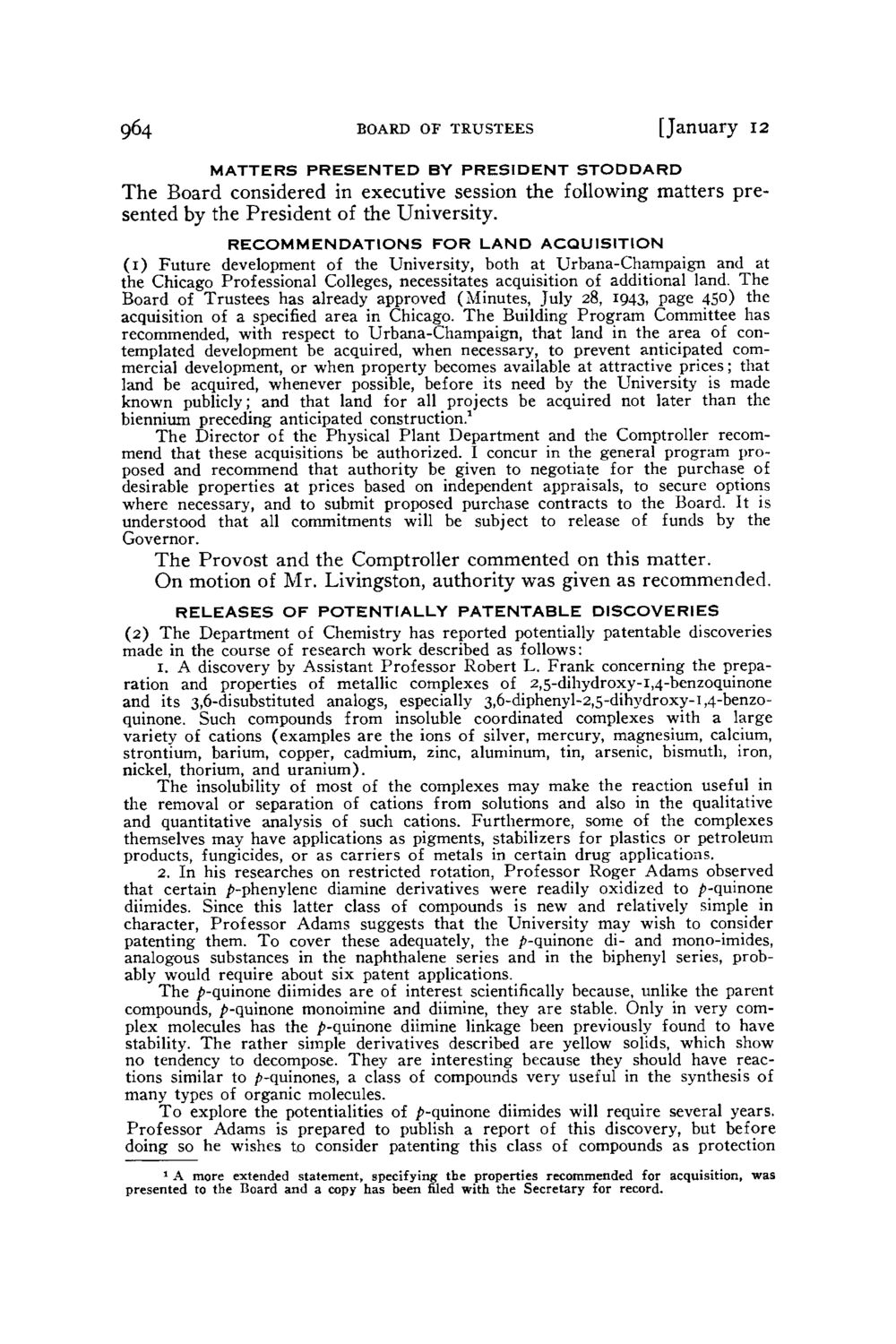| |
| |
Caption: Board of Trustees Minutes - 1950
This is a reduced-resolution page image for fast online browsing.

EXTRACTED TEXT FROM PAGE:
964 BOARD OF TRUSTEES [January 12 MATTERS PRESENTED BY PRESIDENT STODDARD The Board considered in executive session the following matters presented by the President of the University. RECOMMENDATIONS FOR LAND ACQUISITION (1) Future development of the University, both at Urbana-Champaign and at the Chicago Professional Colleges, necessitates acquisition of additional land. The Board of Trustees has already approved (Minutes, July 28, 1943, page 450) the acquisition of a specified area in Chicago. T h e Building Program Committee has recommended, with respect to Urbana-Champaign, that land in the area of contemplated development be acquired, when necessary, to prevent anticipated commercial development, or when property becomes available at attractive prices; that land be acquired, whenever possible, before its need by the University is made known publicly; and that land for all projects be acquired not later than the biennium preceding anticipated construction. 1 T h e Director of the Physical Plant Department and the Comptroller recommend that these acquisitions be authorized. I concur in the general program proposed and recommend that authority be given to negotiate for the purchase of desirable properties at prices based on independent appraisals, to secure options where necessary, and to submit proposed purchase contracts to the Board. It is understood that all commitments will be subject to release of funds by the Governor. The Provost and the Comptroller commented on this matter. On motion of Mr. Livingston, authority was given as recommended. RELEASES OF POTENTIALLY PATENTABLE DISCOVERIES (2) The Department of Chemistry has reported potentially patentable discoveries made in the course of research work described as follows: 1. A discovery by Assistant Professor Robert L. Frank concerning the preparation and properties of metallic complexes of 2,5-dihydroxy-i,4-benzoquinone and its 3,6-disubstituted analogs, especially 3,6-diphenyl-2,5-dihydroxy-i,4-benzoquinone. Such compounds from insoluble coordinated complexes with a large variety of cations (examples are the ions of silver, mercury, magnesium, calcium, strontium, barium, copper, cadmium, zinc, aluminum, tin, arsenic, bismuth, iron, nickel, thorium, and uranium). The insolubility of most of the complexes may make the reaction useful in the removal or separation of cations from solutions and also in the qualitative and quantitative analysis of such cations. Furthermore, some of the complexes themselves may have applications as pigments, stabilizers for plastics or petroleum products, fungicides, or as carriers of metals in certain drug applications. 2. In his researches on restricted rotation, Professor Roger Adams observed that certain />-phenylene diamine derivatives were readily oxidized to />-quinone diimides. Since this latter class of compounds is new and relatively simple in character, Professor Adams suggests that the University may wish to consider patenting them. To cover these adequately, the />-quinone di- and mono-imides, analogous substances in the naphthalene series and in the biphenyl series, probably would require about six patent applications. The />-quinone diimides are of interest scientifically because, unlike the parent compounds, /'-quinone monoimine and diimine, they are stable. Only in very complex molecules has the />-quinone diimine linkage been previously found to have stability. The rather simple derivatives described are yellow solids, which show no tendency to decompose. They are interesting because they should have reactions similar to />-quinones, a class of compounds very useful in the synthesis of many types of organic molecules. T o explore the potentialities of />-quinone diimides will require several years. Professor Adams is prepared to publish a report of this discovery, but before doing so he wishes to consider patenting this class of compounds as protection 1 A more extended statement, specifying the properties recommended for acquisition, was presented to the Board and a copy has been filed with the Secretary for record.
| |